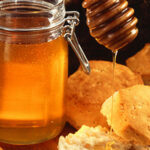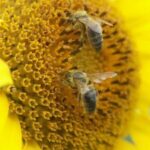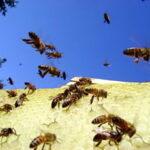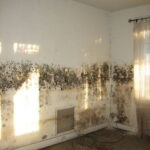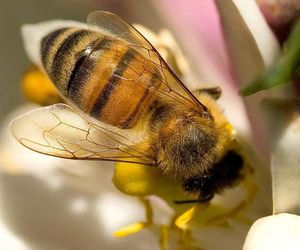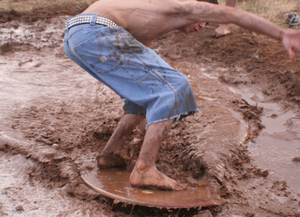As a beekeeping mentor in the Pacific Northwest, I was recently asked to help a backyard apiarist with a mold issue. Upon arrival at the novice’s beautifully manicured garden, I was presented with the sight of a beautifully-constructed, brightly-painted Kenyan top bar hive.
As we suited up in preparation for the inspection, I asked the beekeeper–we’ll call her June–how long it took her to build the hive.
“Oh, I didn’t build it–I bought it,” she replied. She then disclosed a price that nearly put me into apoplectic shock.
Top bar hives, or TBHs for short, have been popular among nongovernmental organizations and missionaries to African countries for many years due to their ease of construction and ease of maintenance. The lateral arrangement of combs–the structures bees create for storage of nectar and pollen, and for raising their young–works well in regions with minimal winter seasons, and thus the two main styles are the Kenyan top bar hive, with v-shaped walls, and Tanzanian top-bar hives, with straight sides.
Top bar hives differ from the typical Langstroth system in several ways. First, as mentioned, they require few (if any) fancy saw cuts, and technically can be made from anything from bisected steel drums to livestock troughs.
Langstroth hives, invented in the mid-19th century as the first removable-comb system of keeping European honey bees, require boxes made of certain dimension and, for durability and strength, the more complicated box joints and rabbeting.
Langstroth hives rely on a vertical arrangement of boxes of combs contained in wooden or plastic frames. Top bar hives rely upon a lateral arrangement of combs, drawn naturally by the bees from unsupported strips of wood.
Langstroth frames usually contain “foundation”, thin sheets of milled beeswax or sometimes wax-coated plastic, as a guide for bees to draw out combs. Top bar hives use “starter strips”, either a bead of beeswax along the center of the top bar, a thin strip hanging from the center of the bar or no guide at all. Newly-made combs in top bar hives can easily collapse, as they do not have end or bottom bars as attachment points, as do the Langstroth frames.
Langstroth hives are the most commonly used equipment among commercial and hobbyist beekeepers, and accessories and do-it-yourself plans are easily available for this style, which relies upon standardized measurements.
The original spirit of top bar hives is that each is unique, and no measurement standards are needed. However, beginners to beekeeping often find themselves unable to find needed feeders and mite treatment delivery options for their TBHs. This is a problem that is often overlooked, but easily prevented.
Since the arrival of the nefarious Varroa mite (Varroa destructor) many beekeepers have replaced the floors of their Langstroth hives with screened bottom boards, allowing falling mites to pass through 1/8-inch mesh screens to removable trays below. Screened bottom boards also allow for increased ventilation, something necessary for wet-climate bees and to increase honey production in hives regardless of region. Top bar hive builders can easily integrate close-able screened bottoms in their own hives, but this feature was missing in my client’s hive.
Also sorely lacking was ventilation. Aside from a hive entrance at one end of the TBH, there were no means of moderating air flow through the hive’s chamber. Thus, the presence of mold.
In addition, the volume of this TBH would have worked well in more arid climates, but it was far too small for a colony kept in Northern regions. My client paid twice the price for half the volume of the recommended two-deep winter Langstroth configuration, which includes as much as 5400 square inches of comb space.
I applaud beekeepers who build their own equipment, or create products for other apiarists. But, in spite of the impeccable craftsmanship of this TBH, I felt that the builder of this hive, who markets them widely in our area, is selling a flawed product at an overinflated price. I don’t think he’s a villain of any sort, because he likely used popular plans being circulated among TBH on-line communities with no personal experience in Northwest beekeeping.
And that’s the rub. Top bar hives have caught on as the new trend among the hobbyist beekeeper, and many new beekeepers with no prior experience are believing the unfounded, new reputation attached to these hives as an easier, more natural alternative to the classic Langstroth hive.
In truth, top bar hives are harder on the honey bee.
It takes 17 pounds of nectar to make one pound of beeswax. Top bar hives require that surplus honey be harvested using the “crush and strain” method, where Langstroth frames are harvested using a barrel-shaped, centrifugal “honey extractor” that allows the honey combs to be reused indefinitely. This results in more efficient use of the hive’s resources.
In cold, winter months, honey bees need to leave the warmth of the cluster to reach honey stores. In Langstroth hives, these stores are typically arranged above the cluster (vertically) where the bees can move UP to the food gradually, using emptied cells to rest in while the bees take turns warming the hive through fanning of their wings.
In TBHs, the bees must move laterally, around combs, to get to their stores. This migration is not at all conducive to the natural, instinctive behavior of bees.
Don’t write of the TBH just yet, though. Top bar hives, if built so that the average person is working at waist-level, are excellent for beekeepers with bad backs. Positioned a bit lower, they’re excellent for chair-bound enthusiasts and smaller adults and children.
When built so that their dimensions allow for the placement of Langstroth-style boxes above the main TBH body, there is no end to the flexibility of this equipment. Langstroth boxes called “supers”, those which are designated for surplus honey, can be stacked above for winter storage, leaving the lower part of the TBH as a brood-chamber.
One can also use Langstroth-type feeder trays, ventilation covers and pollen traps on TBHs that have been built with the same width dimensions.
Before you get involved with any style of beekeeping, give serious thought to your responsibility to these creatures. You’re not doing the bees any favors if all you plan to do is set up a hive and fail to maintain them. Well meaning “natural” beekeepers who believe that by not treating for the important bee diseases may claim they’re propagating a more disease-resistant bee, but in all but the rarest cases, they’re just being lazy. Successful bee breeding requires controlled genetics, impossible to do in an urban/suburban environment, and it’s near impossible to breed for a bee resistant to ALL diseases and vectors at the same time. Sadly, some of the most effective, approved treatments for one of the most serious diseases, including Nosema ceranae, are far from organic, but natural alternatives are earning high marks in scientific studies. My personal favorite treatments against Varroa mites include the organic Formic acid and the mechanical powdered sugar dusting, and neither of these can be used with TBHs without some Langstroth compatibility.
Whatever your reason for wanting a top bar hive in your garden–whether it be to save the bees, enter a hobby the whole family can enjoy, or simply pollinate your garden, go for it. Just remember to evaluate the hype, research the limitations, and be creative in researching modifications to your existing hives, or plans for the next hive you build. And you will have more than one, because once stung by the beekeeping bug, it’s tough to give up the addiction.
